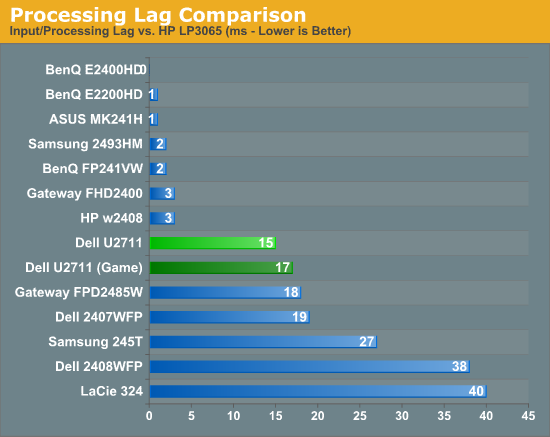Dell UltraSharp U2711: Quality has a Price
by Jarred Walton on January 22, 2010 2:00 AM EST- Posted in
- Displays
Dell U2711 Lag and Response Time
Some users are very concerned with display lag and pixel response time. For others, they really don't notice anything unless a particular display is very sluggish. I fall into the latter camp, though I do notice the processing lag when it's above ~40ms (e.g. on the Dell 2408WFP and LaCie 324, my mouse input just felt off.) To test for display lag, we run the Wings of Fury benchmark in 3DMark03, with the output set to the native LCD resolution - in this case 2560x1440. We clone the output to our reference LCD, an HP LP3065, snap a bunch of pictures, toss out any where the time readout isn't clear, and then average the remaining results (at least 10, and usually 20 or more).
As a reminder, the reference HP LP3065 is one of the best LCDs we currently possess in terms of not having display lag. (The lack of a built-in scaler probably has something to do with this.) While we know some of you would like us to compare performance to a CRT, few users have CRTs these days and all we're really interested in measuring is the relative lag. It's possible we will find an LCD that ends up with a negative result, meaning it's faster than the LP3065, but the best we have managed so far is a tie.

So far, all of the S-PVA panels we have tested show a significant amount of input lag, ranging from 18ms up to 40ms. In contrast, the TN and S-IPS panels show little to no processing lag (relative to the HP LP3065). The BenQ FP241VW with an S-MVA panel performs similarly to the TN and IPS panels, with an average display lag of 2ms - not something you would actually notice compared to other LCDs. What about the new U2711?
We tested with the "Graphics" setting and Adobe RGB as well as "Video" and "Game" - we figured the latter might disable some post-processing and result in less lag. That turned out to be incorrect, as our measured lag actually went up 2ms. However, in practice the settings are pretty much tied. That means the U2711 has around one frame of lag relative to our best LCDs, but it still has a lot less lag than our worst offenders. As stated already, I didn't notice lag in using the U2711 - just like I didn't notice lag on the 2407WFP or the FPD2485W. I did notice slight lag on the Samsung 245T and some clear lag on the 2408WFP and LaCie 324, but the threshold for lag varies and you'll need to determine if 15-17ms is too much or not for you. If you've tried any TN panels and still noticed lag, we would expect every current LCD to be above your "lag threshold".
 |
Despite what the manufacturers might advertise as their average pixel response time, we have found most of the LCDs are basically equal in this area - they all show roughly a one frame "lag", which equates to a response time of around 16ms. Some transitions are faster than others, but the above is representative of what we found in a study of numerous photos. If you look at the tail of the center plane, you can see a slight ghost image before and after the dominant frame. Some of that will come from the camera (we use a 1/120s shutter speed), but most of it comes from the LCD panel. In this case, the U2711 panel does outperform most LCDs that we've tested, where it was often possible to see at least three frames more clearly than the two slight ghosts in the above image.










153 Comments
View All Comments
ninjackn - Friday, January 22, 2010 - link
The color gamut issues stems from issues with applications not using ICC profiles. It was a huge problem in windows XP because so few applications cared to use color profiles. It's gotten a lot better with windows vista/7 (or with OSX) but it still pops up from time to time, specifically with all those images on the web missing color information.Here's a website that shows what i'm talking about:
http://www.gballard.net/psd/go_live_page_profile/e...">http://www.gballard.net/psd/go_live_page_profile/e...
JarredWalton - Friday, January 22, 2010 - link
Okay, I read through that, tried it on Firefox 3.5.7, IE8, and Safari 4. I get the problem now... it's not having a wide color gamut LCD, but rather viewing images that have an ICC profile in applications that don't respect those profiles, right?In terms of internet publishing, I'd have to agree that we need to standardize, and since sRGB is already the standard there's no point in going elsewhere. For an imaging professional where the content isn't going on the web, though, wouldn't you want the better color space? I always "save for web" if I'm going to post an image online, and that strips out any ICC profile information (AFAIK).
I need to go play with this on the U2711 with and without a monitor profile (and using sRGB and Adobe RGB) to see what effect - if any - it has on the experience. Stay tuned....
CSMR - Friday, January 22, 2010 - link
Save for web should give an sRGB label and does with Photoshop CS3. No point in stipping it out.FF is color managed. As soon as IE becomes color-managed it will be fine to use any color spaces in web images. Microsoft has been fairly good about color management of late, so hopefully in IE9, fingers crossed.
velis - Friday, January 22, 2010 - link
To me, this monitor is more interesting from a different viewpoint:It's one of the rare few monitors that offer 2560 resolution at less than 30" size. And even this one only has 109 DPI resolution.
If this monitor was 22 - 24" in size, I'd buy it without second thought.
Of course you need to run Word at 150% magnification, but the fonts look just awesome with so many pixels available to render them. Not to mention games. A "fairly powerful" graphics card is needed though.
The only problem is that current display managers, be it Windows or Linux are all still raster ones and can't really adapt well to increased DPI displays.
Perhaps if more monitors like this would show up on the market, MS and Linux gurus would finally develop true vector user interfaces. Then we could have 150, 200 and even more DPI displays. I'm wondering how many more years before displays catch up to what printers had some 20 years ago already.
CSMR - Friday, January 22, 2010 - link
High dpi is very useable, even with normal pixel pitches 120dpi can be a good option. But yes vector graphics would make the benefit of higher dpi displays even greater.There is vector support in WPF since Vista so Windows is getting there at least.
Plus modern applications (including OS) tend to have raster graphics at various dpis, I think often including 150, so that is improving even without vector graphics.
But the fact is most people don't need very high dpi so we have to wait for the cost to come down. Also for displayport to become common once dvi reaches its limit and that will take a while.
dasgib - Friday, January 22, 2010 - link
I'm really curious about to know if the matte displays of the U2711 has the known "anti-glare effect" which many people complain about on 24" IPS monitors (like the HP LP2475w and Dell U2410)?I don't like glossy displays (as most people do), but I had to send the stated HP display back because of that anti-glare effect.
MadMan007 - Friday, January 22, 2010 - link
I have the HP and it's not bad as far as anti-glare coating although not the best I've seen - that would be a Samsung but sadly it was TN. It helps to sit a reasonable distance away, like a mere 2 feet or more. Every single Dell I've seen is far worse in terms of grainy anti-glare which is a shame because it means I can't consider Dell monitors at all, it just drives me too crazy to see whites all sandy-sparkly-grainy. It really makes me wonder how more Dell users don't even notice it at all.Maybe they've gotten better though? I'd sure like to know.
dasgib - Friday, January 22, 2010 - link
I just asked Jarred about this via email. Hopefully we get an answer soon :)JarredWalton - Friday, January 22, 2010 - link
I haven't noticed any negative effects from the anti-glare coating. I use a Dell 3007WFP normally and haven't ever noticed a problem there either. Mostly, I see the "grainy effect" on cheap TN panels, but maybe I'm just one of those people that isn't bothered by what you're referring to. Anyway, FWIW I feel the U2711 has the same appearance as the 3007WFP and I enjoy the picture. I don't notice "more graininess" or anything like that.MadMan007 - Friday, January 22, 2010 - link
There may be some confusion here over the word 'graininess.' It is not a screen-door effect, pixel pitch by-product or defect in the actual image. It is the screen coating itself - it's not 'grainy' per se in the way a film might be grainy, it's 'sparkly' is my best word for it. Another way to describe it is if you took some sand and lightly dusted the screen surface with it - the image itself looks fine but there's always this layer above it that has its own effect on the image. It makes things 'sparkly' -tiny random dots of coloration across the specturm. For some people it may blend together, I don't know, but I can't see how it's possible to miss entirely. Dell's anti-glare is known to be heavby and particularly prone to this effect which is why it's brought up. Check out forum threads about Dell monitors and you'll find plenty of people noting it.Now someone who uses a Dell monitor all the time may get used to it especially if they never have another monitor next to it. But Jarred you surely have seen a variety of screens. Have you ever set them up side-by-side with your Dell? What about a laptop screen if you have one? Or if you have access to a glossy screen at least to compare, they by nature will not have any anti-glare coating problem.